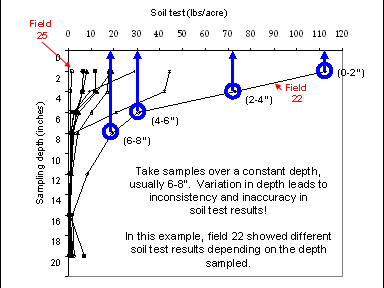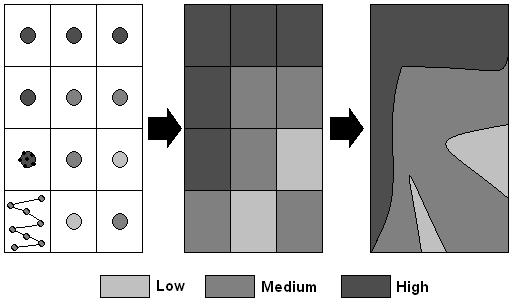Competency Area 3: Soil Testing and Plant Tissue Analysis
PO 20. Describe soil sampling strategies.
- Random sampling
- Grid-based sampling
- Soil-type based sampling
Random sampling is appropriate for fairly uniform fields 10 acres or less in size. It is recommended to take 2-3 samples per acre in a random pattern that covers the field, which reduces the risk of sampling multiple soil types within a field.
Grid-based sampling is useful when there is large within-field variability, if that variability is within the responsive range for nutrients and pH, and if the farmer has the ability to manage based on this variability. The field is divided into small blocks (grid cells of about 1-4 acres each) and a separate sample (consisting of 6-10 sub-samples) is taken from each of these grid cells. Sub-samples may be taken from a small area at the center of the grid cell, or taken randomly from throughout the grid cell. Sample results are compiled either directly into a map showing the different soil test levels and recommendations for each grid cell, or the test results may be statistically smoothed to create a map.
Soil type-based sampling is similar to grid-based sampling, in that a field is divided based on soil type, and samples are taken randomly from within those different areas.
To obtain an accurate soil test:
|
 For proper soil sampling, the soil probe should be inserted into the soil perpendicular to the ground, and to the appropriate depth. (image source) |
To take an accurate soil sample:
- Depth: 0-6 to 0-8 inches for general soil tests. Exceptions include the PSNT (0-12 inches deep) and no-till pH testing (0-1 inch and 0-6 inches).
- Generally, one sample should not represent more than 10 acres (unless past sampling shows minimal differences). Variability is caused by soil forming processes, fertilizer applications, manure spreading, and tillage systems.
- One sample should represent one management unit, considering soil type and past management.

Mehlich-3 to Morgan conversion may provide unsatisfactory results across years and locations (soil types etc.). When using a conversion, one sample per acre annually is only a substitute if the accuracy of the conversion equation has been checked (i.e. sample is split, sent in for both Morgan and Mehlich-3 analysis, and both the true Morgan and the estimated Morgan compare well). |
 |
Strategic soil sampling across a field allows the user to generate a map of the field based on soil types and characteristics. When possible, these characteristics should be incorporated into the management of the area. |
Quick Links
- Competency Area 1: Basic Concepts of Plant Nutrition
- Competency Area 2: Basic Concepts of Soil Fertility
- Competency Area 3: Soil Testing and Plant Tissue Analysis
- Competency Area 4: Nutrient Sources, Analyses, Application Methods
- Competency Area 5: Soil pH and Liming
- Competency Area 6: Nutrient Management and Planning
